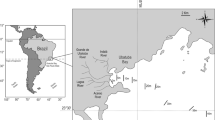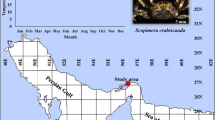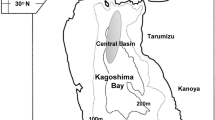Abstract
Crabs of the family Mictyridae are common on sandflats of the Indo-West-Pacific. Activity patterns and population structure ofMictyris longicarpus (Latreille) were monitored in the Haughton River estuary in northeast Australia. The emergence of the crabs at low tide was intermittent and could not be related to lunar cycles, but the crabs were significantly more active on sunny than on rainy or overcast days. Of a total of 1494 crabs measured over a 14 months period, nearly 2/3 were males (951 crabs). No ovigerous females were found on the sandflat surface. Crabs active on the sediment surface ranged in size from 4.7 to 19.7 mm carapace length (CL). Distinct size-frequency distributions were identified for juveniles, females and males. The mean size of juveniles was 7.3 mm and of females 11.2 mm CL. Males showed a bimodal size-frequency distribution. The first mode (mean 8.5 mm) was clearly separated in size from the second mode (mean 15 mm). The population structure remained almost constant throughout the year. Juvenile and adult crabs showed different aggregation patterns and preferred different sediment types.
Kurzfassung
Mictyridae gehören zu den häufigen Krebsfamilien im Indo-West-Pazifik. Aktivitätsmuster und Populationsstruktur vonMictyris longicarpus (Latreille) wurden im Ästuar des Haughton River im Nordosten Australiens untersucht. Das Auftreten der Krebse bei Niedrigwasser war unregelmäßig, ein Lunarrhytmus wurde nicht festgestellt, aber die Krebse waren an sonnigen Tagen signfikant häufiger auf der Wattoberfläche aktiv als bei Regen oder bewölktem Wetter. Von insgesamt 1494 vermessenen Krebsen während einem 14 monatigen Untersuchungszeitraum waren 2/3 Männchen (951 Krebse). Eiertragende Weibchen wurden auf der Wattoberfläche nicht angetroffen. Die bei Niedrigwasser an der Oberfläche aktiven Krebse hatten Größen von 4.7 bis 19.7 mm Karapaxlänge (CL). Juvenile Krebse, Weibchen und Männchen hatten distinkte Größenklassenverteilungen. Die mittlere Göße juveniler Krebse betrug 7.3 mm, die der Weibchen 11.2 mm CL. Männchen hatten eine bimodale Größenklassenverteilung (8.5 mm und 15 mm CL). Die Populationsstruktur blieb über das Jahr weitgehend konstant. Juvenile und adulte Krebse zeigten unterschiedliches Aggregationsverhalten und bevorzugten verschiedenen Sedimenttypen.
Similar content being viewed by others
References
Altevogt, R. (1957): Untersuchungen zur Biologie, Ökologie und Physiologie indischer Winkerkrabben. — Z. Morphol. Ökol. Tiere,46: 1–110.
Cameron, A. M. (1966): Some Aspects of the Behaviour of the Soldier Crab,Mictyris longicarpus. — Pac. Sci.,20: 224–234.
Colby, D. R. &Fonseca, M. S. (1984): Population dynamics, spatial dispersion and somatic growth of the sand fiddler crabUca pugilator. — Mar. Ecol. Progr. Ser.,16: 269–279.
Davie, P. J. F. (1985): The biogeography of littoral crabs (Crustacea: Decapoda; Brachyura) associated with tidal wetlands in tropical and subtropical Australia. — In:Bardsley, K. N. &Davie, J. D. S. &Woodroffe, C. D. [Eds.]: Coastal and Tidal Wetlands of the Australian Monsoon Region. — Austral. Nat. Univ., Mangrove Monogr.,1: 259–276; Darwin, NT, Australia.
Dittmann, S. (1993): Impact of foraging soldiercrabs (Decapoda: Mictyridae) on meiofauna in a tropical tidal flat. — Rev. Biol. Trop.,41: 627–637.
—— —— —— (1995): Benthos structure on tropical tidal flats of Australia. — Helgoländer Meeresunters.,49: 539–551.
Fielder, D. R. (1971): Some aspects of distribution and population structure in the sand bubbler crabScopimera inflata Milne-Edwards, 1873 (Decapoda, Ocypodidae). — Austral. J. mar. Freshwat. Res.,22: 41–47.
Hails, A. J. &Yaziz, S. (1982): Abundance, breeding and growth of the ocypodid crabDotilla myctiroides (Milne-Edwards) on a West Malaysian Beach. Estuar. Coast. Shelf Sci.,15: 229–239.
Hartnoll, R. G. (1973): Factors affecting the distribution and behaviour of the crabDotilla fenestrata on East African shores. — Estuar, coast, mar. Sci.,1: 137–152.
Henmi, Y. &Kaneto, M. (1989): Reproductive ecology of three ocypodid crabs. I. The influence of activity differences on reproductive traits. — Ecol. Res.,4: 17–29.
Kelemec, J. A. (1979): Effect of temperature on the emergence from burrows of the soldier crab,Mictyris longicarpus (Latreille). — Austral. J. mar. Freshwater Res.,30: 493–498.
Koga, T. (1995): Movements between microhabitats depending on reproduction and life history in the sand-bubbler crabScopimera globosa. — Mar. Ecol. Progr. Ser.,117: 65–74.
McNeill, F. A. (1926): Studies in Australian carcinology. 2. A revision of the family Mictyridae. — Rev. Austral. Mus.,15: 100–128.
Murai, M. &Goshima, S. &Nakasone, Y. (1982): Some behavioral characteristics related to food supply and soil texture of burrowing habitats observed onUca vocans vocans andU. lactea perplexa. — Mar. Biol.,66: 191–197.
Palmer, J. D. (1990): The rhythmic lives of crabs. — Biosci.,40: 352–358.
Quinn, R. H. (1980): Mechanisms for obtaining water for flotation feeding in the soldiercrab,Mictyris longicarpus Latreille, 1806 (Decapoda, Mictyridae). — J. exper. mar. Biol. Ecol.,43: 49–60.
-- -- -- (1983): Water uptake and feeding in the soldier crab,Mictyris longicarpus Latreille, 1806 (Decapoda, Mictyridae). — PhD Thesis Univ. of Queensland: 148 pp.
—— —— —— (1986). Experimental studies on food ingestion and assimilation of the soldier crab,Mictyris longicarpus Latreille (Decapoda, Mictyridae). — J. exper. mar. Biol. Ecol.,102: 167–181.
Sleinis, S. &Silvey, G. E. (1980): Locomotion in a forward walking crab. — J. comp. Physiol.,136: 301–312.
Snowden, R. J. &Clayton, D. A. &Al-Taher, E. Y. (1991): Population biology ofIlyoplax stevensi (Brachyura: Ocypodidae) on a Kuwait mudflat. — Mar. Ecol. Progr. Ser.,71: 219–225.
Wada, K. (1981): Wandering inScopimera globosa (Crustacea: Ocypodidae). — Pubi. Seto mar. Biol. Lab.,26: 447–454.
Wenner, A. M. (1972): Sex ratio as a function of size in marine Crustacea. — Amer. Naturalist,196: 321–350.
Author information
Authors and Affiliations
Rights and permissions
About this article
Cite this article
Dittmann, S. Behaviour and population structure of soldier crabsMictyris longicarpus (Latreille): Observations from a tidal flat in tropical North Queensland, Australia. Senckenbergiana maritima 28, 177–184 (1998). https://doi.org/10.1007/BF03043148
Received:
Revised:
Accepted:
Issue Date:
DOI: https://doi.org/10.1007/BF03043148




